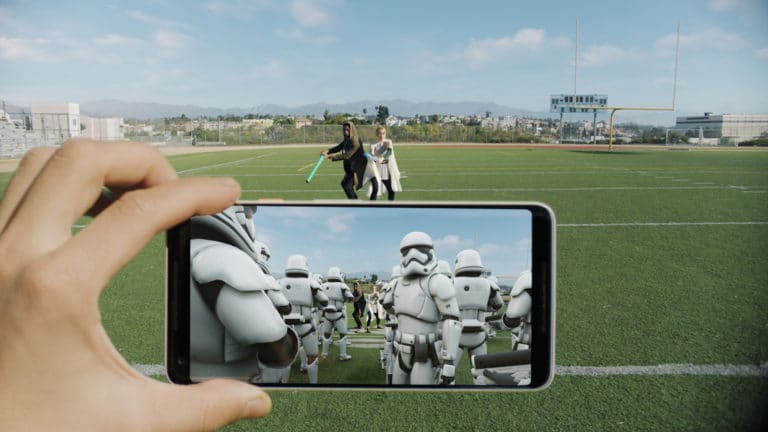
This post is adapted from ARtillry’s latest Intelligence Briefing, AR Business Models: The Top of the Food Chain, Part I. It includes some of its data and takeaways. More can be previewed here and subscribe for the full report.
Last week, we took a look at Google’s motivating factors for investing in and innovating around AR. It turns out that AR — or at least Google’s flavor of AR (e.g. visual search) — aligns nicely with its core search business. It will extend search from text into a visually-immersive era.
Another projected “killer app” for AR will be social interaction, as we’ve examined. AR can add new dimension to the ways that people interact socially and play games in a shared space. Social features also help AR apps grow virally and through social-graph driven network effect.
Google recognizes all of this and is developing ways that AR apps can have more multi-player support. This basically means that social apps and games can be experienced “synchronously” between users so that they interact with the same graphics at the same time (image persistence).
“I think the real unlocking potential of AR rests in two things,” said Google’s Aaron Luber at ARiA. “One is sharing and multiplayer: Your ability to do things in AR with multiple people at the same time… And then of course persistence and being able to leave places and come back to them.”
This concept has since manifested in Google’s AR Cloud Anchors. They standardize tools for ARCore developers to achieve image persistence. And they’ll notably operate across apps built on ARCore and Apple’s ARkit, which should enable more social app sessions to occur.
“Cloud Anchors will enable many new AR experiences that combine the power of your device, your creativity and the people around you,” said Google’s Nathan Martz at I/O. “But because these experiences are so powerful, they should work regardless of the kind of phone you own.”
Back to this report’s core topic of monetization, there are use cases Google has in mind beyond fun and games. As Amazon and IKEA have already done, AR will be a practical and monetizable tool for in-home product visualization. Multi-player functionality can add new dimensions.
“If I’m placing a speaker system here, I can have my wife also look at [it] from her phone,” said Google’s James Birney at I/O. “There’s a feeling of consistency and trust if you’re the advertiser or e-commerce site if you have two users looking at it, and it shows up consistently for both of them.”

Mapping & The AR Cloud
As discussed in May’s Intelligence Briefing, the AR Cloud is critical for AR’s future. It powers 3D spatial maps of physical places that AR devices can dynamically tap. It’s an intelligence layer for AR apps to overlay graphics that are relevant, persistent and dimensionally accurate.
Google is in tune with all of this. In fact, we like to say that the AR cloud is like Google’s search index, but for the physical world. And Google’s existing data assets like Street View imagery will assist Google Lens (examined last week) through object recognition to identify local storefronts.
Going one level deeper, Google has taken active steps to support the construction of the AR Cloud. Its Maps API for XR lets developers utilize the underlying data in Google Maps as a foundation to build virtual worlds. That can be gamescapes in VR, or geo-relevant overlays in AR.
In other words, rather than reinvent the wheel and build virtual worlds for gaming, mapping or other XR apps, developers can “reskin” the graphical data that Google has assembled over years for its mapping engine. That includes 2D lat-long mapping, but also 3D structures and buildings.
Using that data as a framework for virtual worlds, developers can focus instead on other parts of the user experience. And the worlds they build can have additional relevance because they sync with the real world. We’re talking Pokemon Go-like experiences or scavenger hunt games.
But beyond easier world-building, this could have another benefit: object recognition for AR. Given that Google’s map data contains real-world geography and structures, it could be an image database that helps AR devices identify objects – again, like a search index for the physical world.
Once it has that index in place, visual search-based monetization can follow a familiar playbook for Google, with modifications of course. We must point out here that this is a logical and evidence-supported move, but it is our analyst speculation rather than anything Google has announced.
https://youtu.be/OrjIclWmliA
Scale Driven
Speaking of business models, Google is all about things that scale. On that measure, mobile AR currently has more scale than VR, given an installed base of 762 million smartphones. Google’s Aaron Luber stresses that it’s pursuing both AR and VR, but the former has nearer-term returns.
“We’re very focused in both areas but when we look at that total addressable market, it’s obvious that one represents something that is vastly bigger,” he said. “We’re very focused on things that get us into hundreds-of-millions types of numbers, so that’s a huge opportunity.”
And it’s not just the number of users, but frequency. As we examined last week, visual search has a “magic combination” of frequency and utility. There again, AR wins over VR due to more eligible hours per day for active usage — where VR is disadvantaged by technological invasiveness.

“VR is something that we hope that people will do once per day if we’re lucky,” said Luber at ARiA. “The use cases are fundamentally different. VR, we’re learning, is focused on entertainment… AR is more focused in utility and things that people are going to do multiple times per day.”
Lastly, Google shows interest in standalone VR, where Daydream will power the Lenovo Mirage and other headsets that compete with Oculus Go. And like the above factors, standalone VR feeds Google’s hunger for scale, as reduced friction and price will bring VR to greater numbers.
“I look at all the barriers to entry in VR that have existed today.” Added Luber. “What hasn’t existed today is a purpose-built, purposely-purchased standalone headset and the ability to pick that up and be in VR in five seconds. That’s a big deal. That’s a big opportunity for consumers.”
To continue reading, see ARtillry’s latest Intelligence Briefing, AR Business Models: The Top of the Food Chain, Part I. Also see the first part of this analysis on Google, which published last week.
For deeper XR data and intelligence, join ARtillry PRO and subscribe to the free ARtillry Weekly newsletter.
Disclosure: ARtillry has no financial stake in the companies mentioned in this post, nor received payment for its production. Disclosure and ethics policy can be seen here.
